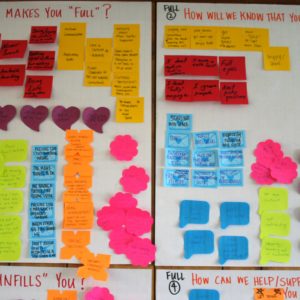Reader and fluency game player Jay Bazuzi commented recently:
In a month I’ll be visiting my grandmother and want to learn her language from her, so I’m eager to learn how to use WAYK for other spoken languages.
I’ve been following the roadmap myself, practicing with the videos, friends, and kids. I’m getting pretty comfortable with Want/Have/Give/Take.
Should I plan to play with her in English + sign, to teach her signing fluency? And then modify the sign to her native tongue? It seems like a lot to ask of her. She’s a good sport, but she’s old, and I want to be gentle with her.
This question really illuminates where the rubber meets the road. I’d like to make sure all the other WAYK fans see the response I gave Jay:
It sounds like you’ve entered the territory of technique “Language Hunting”.
WAYK operates in many contexts; it all comes to down to contextualizing the game, and the skills of flow play and technique use that you’ve developed.
You know better than me if your grandmother has the energy and interest to learn some sign. Certainly if she does, it will accelerate the learning process in several respects. But you have other tools at your disposal.
Usually, especially with endangered languages, we do run into elders who don’t have the energy or time available to learn the WAYK game. Think of that game as your learning lab, where you developed and honed all the skills that you will now take out into the world and “language hunt”.
Playing with doing everything with your grandmother that you do in a WAYK game, but just silently and secretly, for yourself, without marking techniques for her.
Setup a conversation that will interest her and she will find easily accessible; perhaps about having tea. Then immediately, “obviously” your nouns jump to mind, that you have to discover one by one (cup, tea, sugar, etc.). You have your “set up” space to keep as simple as possible for your own sanity. You have the “set-up” conversation ready to go. Plan to have this “same conversation” over and over with her. “Limit” the conversation to each tiny piece as it comes, to the very next word or structure you need. “Sorry charlie”, internally, any attempt on her (or your!) part to make it too complicated. Because ASL mimics actual objects and actions, continue using the sign as a “bridge language” for yourself, and it will also help your “fluent fool” to understand what you mean and want.
And so on. Do you see? The game develops learning skills, not a static unchanging format that you must lug from one situation to another. The core game acts as your learning laboratory; what you learn there, you take out into the chaotic, churning world of situations and personalities, using your new technique skills for your own benefit.
The fluency game reaches its full potential when a community uses it as a language and relationship of learning/teaching. You can “language hunt” by yourself, and experience great success and incredible speed moving along the “Travels with Charlie”; but when a community does this together, hunting and feeding each other as informed players – watch out!





This language acquisition tool is amazing. I recently went to Hawaii with my boyfriend and after four 2-hr sessions with a Hawaiian language teacher he was able to hold a simple conversation with her. I would never have believed it if I had not seen it for myself. And they had a lot of fun together in the process, she (the teacher) sure enjoyed being introduced to this new technique for using in her classes and as a tutor.